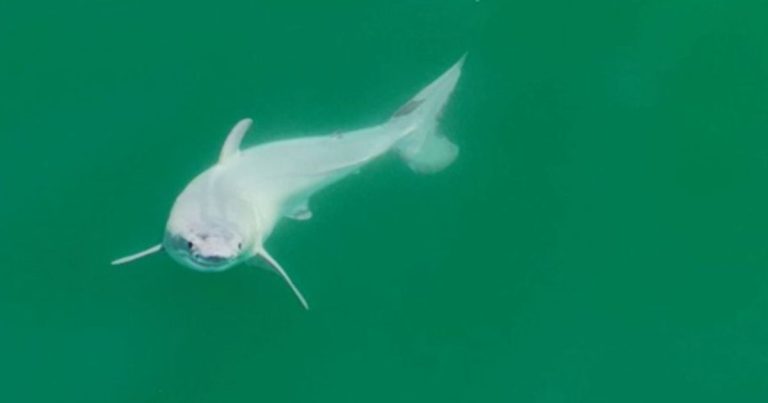A California duo recently made a discovery they refer to as the “holy grail of shark science.”
Philip Stearns, a biology doctoral student at UC Riverside, and Carlos Gaona, a wildlife filmmaker, captured images of a newborn great white shark shedding its embryonic layer in July 2023, according to SFGate.
The duo's findings were published on January 29 in the scientific journal Environmental Biology of Fishes.
This may be the first time such an event has ever been recorded.
“Capturing this moment…is the holy grail of shark science,” Stearns told SFGate. “You're looking for such a specific moment in time and space. To be there in the right place at the right time… you're talking about very slim chances. It's groundbreaking.”
Stearns and Jonah noticed the baby shark off the coast of Carpinteria, California. The two men were flying a drone over the water when a pale white shark caught their attention.
They knew immediately that they had something special on their hands.
“I just heard him say, 'Wow,'” Stearns recalled. “I leaned over and stood right behind him, and we saw this white object appear on the screen. I almost fell out of my seat from excitement.”
At first, they thought they were observing an albino shark, which would have been an extremely rare sighting in itself.
However, Stearns noted that the shark was rather small, only about 5 feet long, and had rounded fins, a characteristic of newborn or fetal sharks.
The shark's pale white color appeared to be caused by a film-like substance that was peeling from its body. That's when the duo realized this must be a newborn shark shedding its embryonic layer.
“We were absolutely blown away,” Stearns said.
The 'Holy Grail' of shark science: A newborn great white shark captured on video for the first time ever https://t.co/KYf5X4wRTc #Sciences
-Bron (@Bronzeis) January 30, 2024
Scientists have speculated that the coastline from Santa Barbara to Baja California is a birthing site for great white sharks. However, because this species is so elusive, not much is known about its reproductive process.
“It's one of our biggest mysteries: Where do they mate? Where do they give birth? This is just a dead zone despite the markings we do,” Stearns noted.
This unique and profound discovery shows us how much we can learn about God's creation.
Although humans have dominated the Earth for thousands of years and explored it extensively, there are still many places that humans have not or cannot explore.
Take the deepest point in the Pacific Ocean, Challenger Deep, for example. Only a few humans have traveled to this location, spending a lot of time and money doing so. However, little is still known about the mysterious abyss. Scientists aren't even sure how deep Challenger Deep actually is.
It's safe to say that we still have a lot to learn about our planet.
“We have better maps of the Moon and Mars than we do of our own planet,” said Dr. Gene Feldman, NASA oceanographer emeritus.
So, even though we may not explore every corner of the Earth or witness the many wonderful things that happen in the wilderness every day, we can still be thankful to God for all the beautiful things we can observe.
This article originally appeared in The Western Journal.

